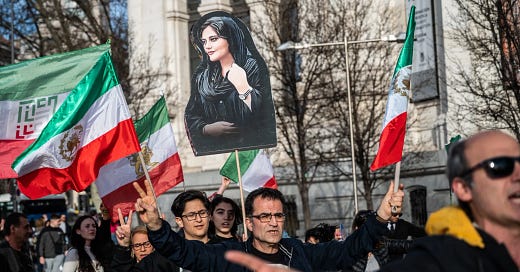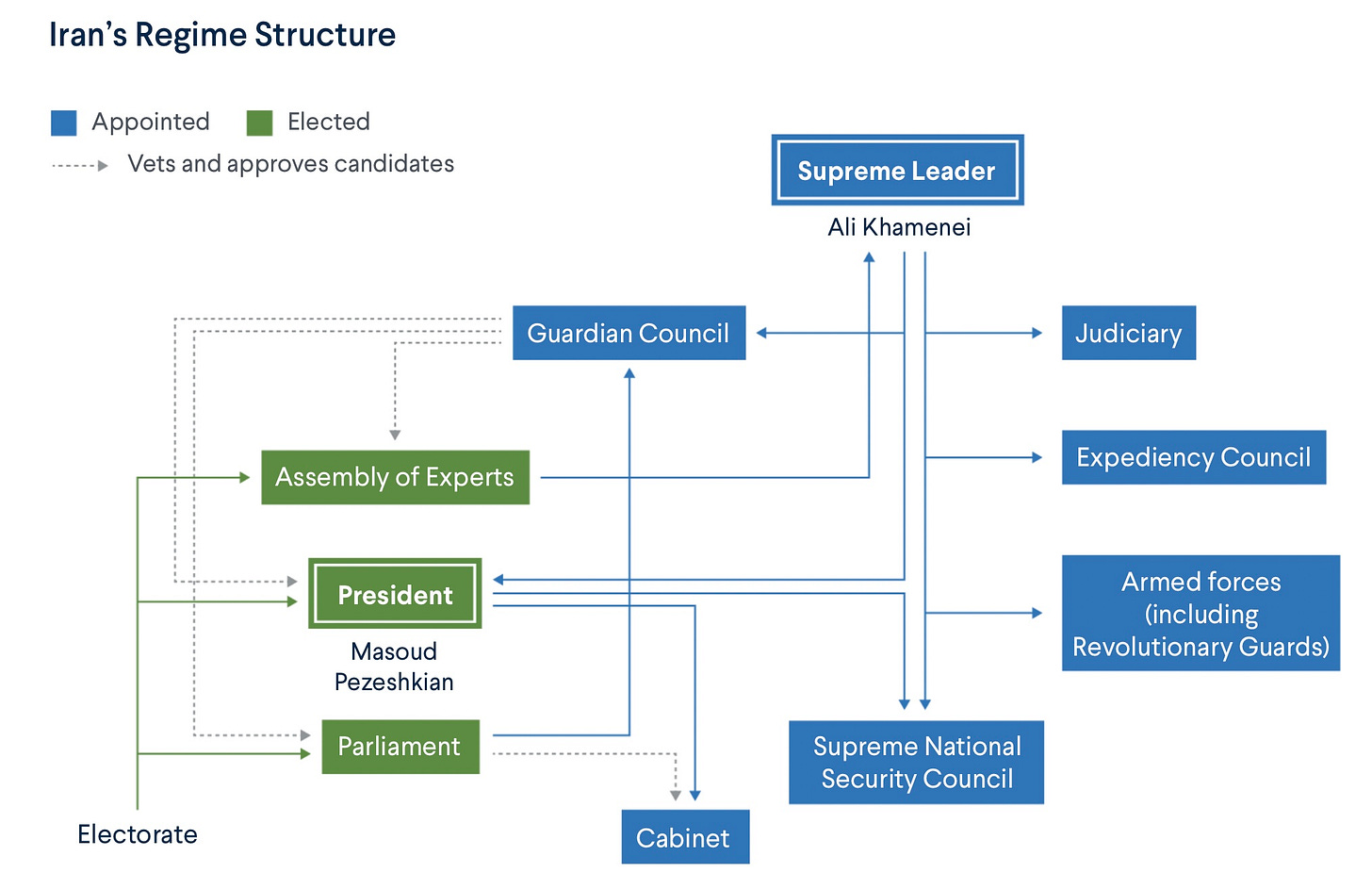The Iranian Regime
How the Islamic Republic works — and why so many Iranians hope for regime change.
By Michael Golden
The Islamic Republic of Iran is what it sounds like: a theocracy. It is an autocratic form of government where a Supreme Leader calls the shots according to his interpretation of a religion.
Iran was a monarchy for centuries before 1979. A revolution that year took out the Shah of Iran, Mohammad Reza Pahlavi, and installed the country’s first “Supreme Leader,” Ruhollah Musavi Khomeini. Here’s how the Iranian regime works:
Shia Islam is the regime’s official religion, versus the other major branch of Islam, Sunni.
The Supreme Leader, currently Ali Khamenei, makes all decisions: he is in control of the executive, legislative (290-seat parliament) and judicial branches of the government — as well as the military and Iran’s state-run media.
The Guardian Council is a 12-person entity that vets all candidates and decides who is qualified to run for any position in government. In other words, they control who “represents” the people of Iran. The Guardians consist of six “faqihs” (experts on Islamic law) and six other “jurists.” The Guardian Council applies its interpretation of Islam to make or veto laws — all ultimately subject to the control of the Supreme Leader.
An Assembly of Experts is a body of 88 jurists that the Iranian Constitution vests with the power to elect the Supreme Leader. The Assembly has never taken action to remove a Supreme Leader.
A President of Iran is vetted prior to his election. Once in office, he sets policy and executes laws, once again subject to the parameters of the Supreme Leader.
The Islamic Republic has cracked down on public criticism of its reign since the beginning; mass executions and imprisonments took place as early as the 1980s. Forty years later, journalists have a hard time contacting dissidents inside the country. The regime limits access to online activity and social media.
Historically, Iran has been home to a longstanding Jewish community. But between 1950 and today, the Jewish population dwindled from 150,000 to less than 15,000. And over recent years, Iran has become the most anti-Israel country in the Middle East — even as its neighbors are moving on. Again, we’re talking about a theocratic autocracy, with laws that must align with Shia tenets.
The Iranian government government has advocated for the destruction of Israel ever since the 1979 revolution. This stance is embedded in Iran’s official communications, state-sponsored education, military programs, and is publicly bannered each year on "Quds Day."
Similarly, Iran’s attitude and actions toward the United States have been oppositional and frequently violent since the revolution. Radicals took 52 Americans hostages in 1979 from the American embassy in Tehran, and that was just the beginning. Iran was behind the bombing of the U.S. Marine barracks in Beirut in 1983 and provided weapons and IED’s to Iraq fighters that were used to kill 196 Americans during the Gulf War. The Supreme Leader was very clear in his intent: “Death to America.” The list of attacks on Americans committed by the Islamic Republic and its proxies is long.
The notorious Evin prison in Tehran, which holds thousands of prisoners, is known for its horrifying conditions. The regime has caged hundreds of dissidents there without due process, including journalists, lawyers, politicians, and students.
In 2022, an Iranian woman named Mahsa Amini was arrested by the “morality police” for violating the hijab law — which requires girls and women to cover their hair and bodies. When Amini died in a hospital while in police custody, it triggered a nationwide protest called the “Mahsa movement.” It was the most muscular challenge to the theocracy since 1979, but Khameini’s security forces ultimately quelled it by arresting thousands of protesters — and killing nearly 500 of them.
All countries are to a large degree reflective of their people. At the same time, countries are reflections of their governments. The problem is that not all people get to choose their government. Once upon a time that was us.
Not having a real choice in selecting who will exert power over their lives is a sad reality for millions of Iranians. Would they collectively choose different leaders if they could? It’s highly likely, but we can’t know the answer to that question unless and until there’s a different form of government in place.
Though Israel and America both have critical stakes in preventing Iran from developing nuclear weapons, Israel’s proximity and target-status in Iran’s eyes make it a more existential threat. That’s why Prime Minister Benjamin Netanyahu has long planned to take out the Iranian nuclear threat by force. The Israel Defense Forces’ recent successes in weakening Hamas, Hezbollah, and Iran’s defense systems paved the way for Netanyahu to launch Operation Rising Lion on June 12. That bold action and its outsize success teed up the bombing that President Trump ordered nine days later.
Beyond the protests a few years ago, there’s plenty of data to indicate that a great many Iranians are unhappy with their country’s system of government. A 2023 survey by the Gaaman Institute of 158,000 people living in Iran revealed that more than 80 percent would prefer to live in a democracy. An accompanying statistic: Iran ranks 117th in the World Happiness Report out of 156 countries.
It is still the people of Iran who’ll need to unite and stand up a sustained rebellion to get something different. To get a rules system that values their lives and their voices — and helps increase stability in their region of the world.
When you look at the 2022 protests, and Iranians’ mixed reactions during this conflict, it doesn’t look like a successful revolution is yet in the offing. But we do know that there is an appetite for it. And we know that it is possible.







